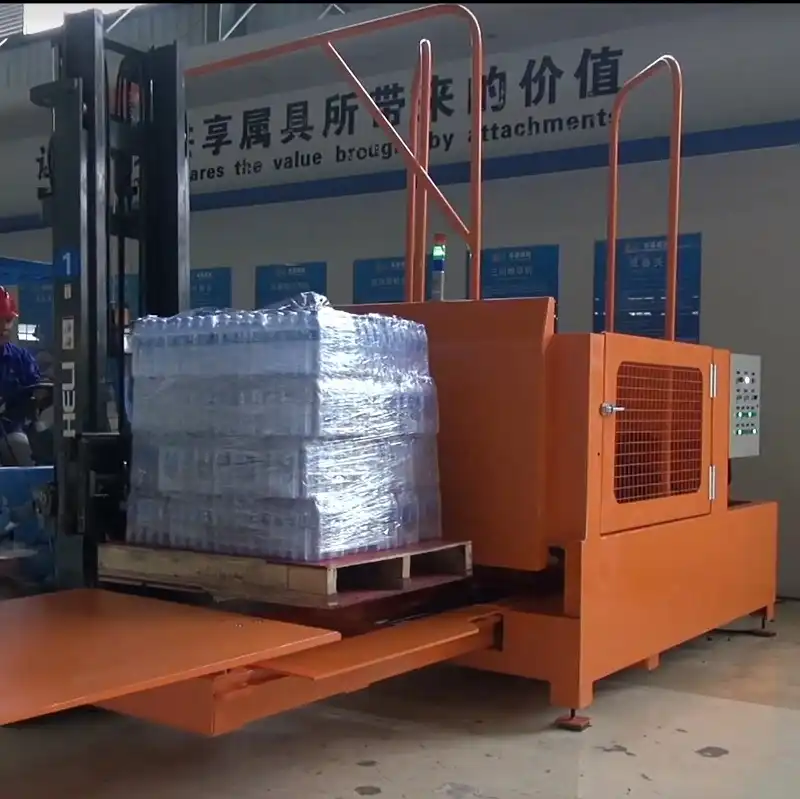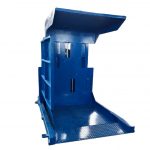How Pallet Inverters Help You Meet Safety Standards in Your Warehouse
- How Pallet Inverters Help You Meet Safety Standards in Your Warehouse
- Introduction
- 1. The Importance of Safety in Warehouse Operations
- 2. How Pallet Inverters Work
- 3. Meeting OSHA Standards with Pallet Inverters
- 4. Reducing Manual Handling to Prevent Injuries
- 5. Improving Load Stability and Preventing Tip-Over Accidents
- 6. Reducing Forklift Traffic and Related Hazards
- 7. Ergonomics and Worker Fatigue Reduction
- 8. Ensuring Consistency in Load Handling
- 9. Lowering Workplace Injury Costs
- 10. Selecting the Right Pallet Inverter for Your Warehouse
- Conclusion: Pallet Inverters as a Critical Safety Tool in Modern Warehouses

Introduction
Maintaining a safe working environment is crucial for any warehouse, and pallet inverters play an essential role in achieving this. By integrating pallet inverters into your operations, you can not only streamline processes but also significantly reduce the risk of accidents and injuries. In this article, we will explore how pallet inverters can help you meet safety standards in your warehouse, reduce labor strain, and improve overall efficiency. Whether you’re dealing with heavy loads, awkward product shapes, or tight spaces, pallet inverters are a reliable solution to enhance both safety and productivity.
1. The Importance of Safety in Warehouse Operations
Warehouses are bustling environments where large machinery, manual labor, and fast-paced workflows come together. This dynamic can often lead to potential safety hazards. According to industry reports, lifting-related injuries are among the most common incidents in warehouses, often resulting from manually handling heavy pallets. Beyond that, pallets can tip, shift, or collapse during transit, leading to dangerous situations. Meeting safety standards is not only a regulatory requirement but a moral imperative to protect workers and minimize accidents.
Pallet inverters help mitigate these risks by enabling operators to handle loads safely and efficiently, reducing manual handling. These machines are specifically designed to support ergonomic lifting and turning, preventing the muscle strain and fatigue commonly associated with manual pallet handling.
2. How Pallet Inverters Work
Understanding how pallet inverters function is essential to appreciating their safety benefits. A pallet inverter is a machine that rotates loaded pallets 180 degrees, allowing easy access to swap out damaged pallets or reposition products. The load stays secure throughout the rotation, minimizing the risk of items falling or being dropped.
For example, when products are received on damaged pallets, it’s unsafe to continue using those pallets in transit or storage. Instead of manually transferring the goods onto a new pallet—an activity prone to causing back injuries or mishandling—operators can simply invert the entire load, replace the faulty pallet, and rotate the goods back into position.
This not only minimizes manual intervention but also ensures a safer and more controlled process. By keeping workers away from heavy lifting and unstable loads, pallet inverters help you adhere to OSHA guidelines that prioritize the reduction of hazardous manual handling activities.
3. Meeting OSHA Standards with Pallet Inverters
One of the key safety regulations in warehouse operations is ensuring that your workplace is compliant with OSHA (Occupational Safety and Health Administration) standards. OSHA focuses heavily on minimizing worker exposure to risks like heavy lifting, repetitive strain, and unsafe load handling. Pallet inverters align perfectly with these guidelines by reducing the need for manual lifting, which is a significant contributor to warehouse injuries.
OSHA guidelines emphasize the importance of providing mechanical assistance whenever possible, and pallet inverters serve as a practical solution. These machines allow for safe load transfers, eliminating the need for warehouse employees to manually adjust or lift heavy pallets, which can weigh several hundred kilograms.
4. Reducing Manual Handling to Prevent Injuries
One of the biggest advantages of incorporating pallet inverters into your warehouse is the drastic reduction in manual handling. Manual handling includes any activity where employees are required to lift, carry, or move heavy items, which is a leading cause of workplace injuries.
According to industry statistics, approximately 25% of all warehouse injuries stem from improper lifting techniques or overexertion while moving heavy objects. Pallet inverters drastically reduce these risks by automating the lifting and rotating process. This not only protects workers from injuries but also ensures that loads are handled with care, preventing product damage and financial losses associated with damaged goods.
5. Improving Load Stability and Preventing Tip-Over Accidents
A common safety issue in warehouses is the instability of palletized loads, especially when goods are stacked unevenly or when the pallet is damaged. When a pallet load becomes unstable, there is a high risk of tip-over accidents, which can result in both product loss and injury to nearby workers.
Pallet inverters solve this problem by securely clamping the load during rotation, keeping everything in place. This feature significantly reduces the likelihood of a load collapse. Moreover, pallet inverters can be adjusted to handle various pallet sizes, ensuring that loads of different dimensions remain stable during inversion.
By improving load stability, pallet inverters also reduce the chances of accidents caused by shifting products during storage or transportation.

Get Your Best Solution !
6. Reducing Forklift Traffic and Related Hazards
Forklift operations, while necessary in warehouse environments, also pose serious safety hazards if not properly managed. Forklift-related accidents are one of the leading causes of injury in warehouses, often due to high traffic, improper load balancing, or operator fatigue. By integrating pallet inverters into your operations, you can significantly reduce the need for forklift intervention during pallet exchanges or product handling.
With a pallet inverter, fewer forklifts are needed to manually lift and rotate pallets, reducing overall forklift traffic on the warehouse floor. This, in turn, minimizes the risk of collision between forklifts and workers, as well as other hazards associated with moving heavy loads through tight spaces.
7. Ergonomics and Worker Fatigue Reduction
Ergonomic design is a critical consideration for any equipment used in warehouse operations. Pallet inverters help address ergonomic concerns by eliminating the need for workers to manually lift and twist heavy loads, actions that often lead to musculoskeletal injuries.
By automating these processes, pallet inverters not only prevent immediate injuries but also reduce long-term wear and tear on workers’ bodies. This reduction in physical strain leads to lower absenteeism and higher productivity, as employees are less likely to suffer from chronic pain or fatigue associated with manual pallet handling.
8. Ensuring Consistency in Load Handling
Another key advantage of using pallet inverters is the consistency they bring to warehouse operations. Manual pallet handling can lead to mistakes, such as uneven stacking, improper load distribution, or handling errors that can compromise product safety.
Pallet inverters ensure that every load is handled with the same level of care, regardless of its size or weight. This consistent handling helps prevent damage to goods and maintains the integrity of the palletized load, reducing the chances of product loss due to human error.
9. Lowering Workplace Injury Costs
Injuries in the workplace can result in significant costs for businesses, from direct medical expenses to lost productivity and workers’ compensation claims. According to the National Safety Council (NSC), workplace injuries cost U.S. businesses billions annually, with musculoskeletal disorders accounting for a large portion of that sum.
By investing in pallet inverters, companies can dramatically reduce their exposure to these injury-related costs. Fewer manual lifting tasks mean fewer opportunities for injury, which translates into fewer insurance claims and lower workers’ compensation premiums. In the long run, this investment pays off both in terms of worker safety and financial savings.
10. Selecting the Right Pallet Inverter for Your Warehouse
When choosing a pallet inverter, it’s important to consider the specific needs of your warehouse. Factors like load size, weight, and the types of products being handled will influence your decision. Some inverters are better suited for large-scale operations, while others are designed for more specialized tasks.
Additionally, it’s essential to select a pallet inverter with adequate safety features such as secure clamping mechanisms, variable speed controls, and ergonomic designs. These features not only enhance the safety of your operations but also ensure that the pallet inverter can adapt to various handling requirements.
Conclusion: Pallet Inverters as a Critical Safety Tool in Modern Warehouses
In conclusion, pallet inverters play an essential role in helping warehouses meet safety standards while boosting productivity and efficiency. By reducing manual handling, preventing injuries, improving load stability, and protecting products, pallet inverters offer a comprehensive solution for modern warehouses. Moreover, their ability to reduce workplace injury costs and enhance worker satisfaction makes them a worthwhile investment for any business aiming to create a safer and more efficient workplace.
As warehouse operations continue to evolve, technologies like pallet inverters will become even more critical in ensuring that companies can meet safety regulations and keep pace with industry demands. Investing in these systems today is not just a smart move for safety—it’s a step toward building a future-ready, highly efficient warehouse.

Get Your Best Solution !








